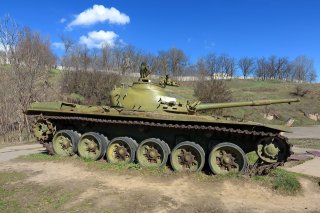Russia's Old T-62 Are Getting Destroyed in Ukraine
Before launching its unprovoked invasion of Ukraine nearly three years ago, the Russian military had the world's largest tank force—at least on paper. However, even then, military analysts saw Russia's tank force as a "paper tiger" as many of the vehicles dated back decades and were kept in storage with little to no ongoing maintenance.
After nearly three years of heavy fighting in Ukraine, the countryside has become a graveyard of military hardware, notably main battle tanks (MBTs). What is unique about the conflict is how the armored behemoths from essentially different "eras" are now rolling over the same ground, often meeting the same fate.
Platforms that might have been considered obsolete are also used alongside cutting-edge technology—and the newest hardware clearly has the advantage.
That fact was noted as drone operators from the Rarog Battalion of the 24th Mechanized Brigade of the Armed Forces of Ukraine released a video that allegedly showed four Russian tanks being destroyed by unmanned aerial systems (UAS) in the Bakhmut sector earlier this week.
The tanks were T-62s, a model likely older than some of the parents of the current tank crews!
How Did Old Tanks End Up on the Front
Before launching its unprovoked invasion of Ukraine nearly three years ago, the Russian military had the world's largest tank force—at least on paper. However, even then, military analysts saw Russia's tank force as a "paper tiger" as many of the vehicles dated back decades and were kept in storage with little to no ongoing maintenance. Questions were raised as to how many of those antiquated vehicles were operational and how effective tanks from the 1960s would fare on the modern battlefield.
The answers came after Russia was unable to deliver a swift victory in Ukraine, and saw hundreds of its modern MBTs destroyed. As the war dragged on, and losses outpaced the production of new tanks, the Kremlin refurbished those old tanks from the Cold War, returning them to service.
It is apparent that Russia was desperate.
Some of the tanks sent to the front lines would seem better suited in a museum or in a historical reenactment than in modern combat. That certainly included the T-62, a platform that was first introduced more than six decades ago.
Developed from the T-54/55 series Soviet tanks, the T-62 was actually considered a very good tank in its day—and it did introduce many design features that became standard in future Soviet and Russian mass-produced tanks, including the T-72, T-84, and T-90. It has been touted as being easier to operate and easier to maintain, but those are hardly selling points given how outclassed the T-62 is compared to modern platforms—not to mention drones.
To put it in historical perspective, the medium tank was introduced before the United States military even adopted the AR-15/M16 as its standard rifle!
Numbers Matter More Than Capabilities For Russia
Production of the T-62 ended in 1975, with more than 22,000 units being produced. Instead of selling off its old stocks of tanks as newer and more capable models were introduced during the Cold War, the Soviet Union often kept older platforms in reserve.
Yet, those tanks sat for years, and then decades, in storage. Instead of ever cleaning out the arsenals, the stockpile built up, and that's how Russia ended up with a massive number of tanks.
Of the 22,000 produced, Moscow inherited around 2,000, and most remained in open-air storage depots. While the Kremlin did refurbish some in the past decade for service with the Syrian military, as many as 1,200 were still held in reserve.
Quantity Doesn't Mean Quality
Those "vintage" tanks have been steadily making their way to Ukraine to bolster Russia's forces and replace the losses of more modern and capable vehicles.
"They're not great tanks—and they're definitely inferior to Ukraine's most numerous T-64s and vulnerable to its mines, drones, artillery and missiles. Analyst Andrew Perpetua described the T-62s as 'vaguely useful.' But only by '1980s standards,'" David Axe wrote for Forbes last summer, adding, "But vaguely useful old tanks are the best Russia can get as long as its losses in Ukraine greatly outpace the manufacture of new tanks."
What is surprising, too, is which units have been supplied with the T-62s. It was reported early last year that the 1st Guards Tank Army (1 GTA), purported to be Russia's premier tank force, was even equipped with the T-62s to make up for previous losses. The unit had previously been due to receive the next-generation T-14 Armata MBT but instead received the T-62.
This speaks to the desperate situation Russia finds itself in.
However, given that at least four T-62 tanks were lost in recent days should give Russia pause about whether the T-62 is even worse than "vaguely useless." Getting trained crews killed in the latest offensive seems to be an ineffective strategy.
Author Experience and Expertise: Peter Suciu
Peter Suciu is a Michigan-based writer. He has contributed to more than four dozen magazines, newspapers, and websites with over 3,200 published pieces over a twenty-year career in journalism. He regularly writes about military hardware, firearms history, cybersecurity, politics, and international affairs. Peter is also a Contributing Writer for Forbes and Clearance Jobs. You can follow him on Twitter: @PeterSuciu. You can email the author: [email protected].
Image Credit: vaalaa / Shutterstock.com

